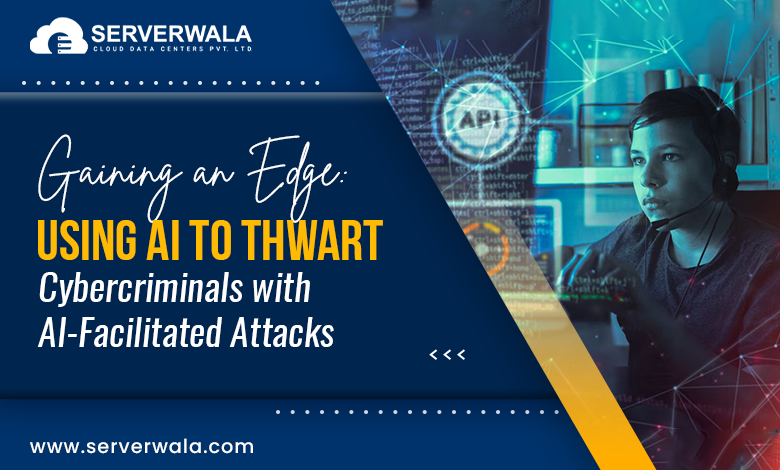Gaining an Edge: Using AI to Thwart Cybercriminals with AI-Facilitated Attacks

Introduction
In today’s digital landscape, cybercriminals are leveraging artificial intelligence (AI) to enhance the sophistication and success rates of their attacks. This evolution has led to more targeted, faster, and more destructive cyber threats, challenging traditional security measures. AI enables attackers to automate phishing campaigns, craft malware that adapts to defenses, and exploit vulnerabilities at a scale previously unimaginable.
This blog explores how cybercriminals are using AI to innovate their tactics and strategies, creating a pressing need for organizations to rethink their security measures. It also delves into the role of AI as a double-edged sword in the cybersecurity landscape—fueling both attacks and defense mechanisms. From real-world examples to actionable insights, this discussion will equip you with a deeper understanding of the AI-powered threat landscape and how to stay one step ahead.
What are Cybercriminals with AI?
Cybercriminals with AI are malicious actors who exploit AI technologies to enhance the scale, precision, and effectiveness of their attacks. These criminals use advanced techniques like:
- Crafting Convincing Phishing Emails: AI-powered natural language processing (NLP) helps create highly personalized and persuasive emails. These can trick even the most cautious users into divulging sensitive information.
- Adaptive Malware Development: Malware integrated with AI can evade detection by modifying its behavior or signature based on the security environment.
- Automated Large-Scale Attacks: AI enables cybercriminals to execute and coordinate attacks on multiple systems simultaneously, reducing manual effort.
AI’s integration into criminal activities enables attackers to bypass traditional defenses easily. For instance, AI can identify security gaps in real-time and exploit them faster than human attackers. Deepfake technology, another tool in their arsenal, is used for fraud, identity theft, or blackmail by generating realistic but fake audio or video content.
This growing reliance on AI makes cybercriminals more unpredictable and effective, presenting a formidable challenge to conventional cybersecurity measures.
Role of AI in shaping both offensive and defensive strategies in the cybersecurity landscape

AI has a transformative impact on cybersecurity, serving as a powerful tool for both attackers and defenders.
Offensive Role of AI
- Automating Intrusions: AI tools scan vast networks, identify weak points, and initiate attacks with minimal human intervention.
- Enhancing Social Engineering: Deepfake videos and voice impersonation make social engineering attacks more believable and impactful.
- Data Exfiltration: AI speeds up the extraction of sensitive data by identifying and prioritizing high-value targets in compromised systems.
- Creating Polymorphic Malware: AI-powered malware changes its code dynamically to evade detection by traditional antivirus tools.
Defensive Role of AI
- Anomaly Detection: AI monitors patterns in network traffic and flags unusual activities that might indicate a breach.
- Threat Prediction: Machine learning models analyze past attack trends to predict and preempt potential threats.
- Incident Response: AI-powered systems automate responses to mitigate attacks quickly, minimizing damage.
- Real-Time Security Monitoring: AI continually scans for vulnerabilities and keeps security systems up to date with evolving threats.
This dual role of AI creates a technological arms race between attackers and defenders.
How has AI helped your company stay ahead of cybercriminals?

Integrating AI into our cybersecurity infrastructure has been a game-changer. It has transformed how we detect, analyze, and respond to threats, ensuring a proactive stance against cybercriminals. Here’s how AI has made a significant impact:
1. Swift Threat Detection and Response
- Real-Time Monitoring: AI-powered systems continuously monitor network traffic for unusual activities. For example, anomalous login attempts or irregular data transfers are flagged immediately.
- Reduced Response Times: AI tools automate threat response processes, cutting response times from hours to minutes. Studies show that AI-enabled cybersecurity systems reduce the average response time to breaches by 96% (source: IBM Security Report).
- Incident Containment: Automated containment protocols ensure that detected threats are isolated quickly to prevent further damage.
2. Enhanced Threat Intelligence
- Pattern Recognition: AI-driven analytics identify subtle patterns that may indicate potential threats. These patterns are often too complex or subtle for human analysts to detect.
- Predictive Analysis: AI leverages historical attack data to predict and prevent future threats. A report by Cybersecurity Ventures highlights that predictive AI tools can mitigate up to 85% of potential threats before they materialize.
3. Improved Security Posture
- Comprehensive Coverage: AI systems cover vast areas of our IT infrastructure, ensuring no weak spots are left unguarded.
- Behavioral Analysis: AI tools study user and device behavior over time. They generate alerts for abnormal actions, such as unauthorized data access or unusual file modifications.
- Adaptive Defenses: Machine learning models evolve with the threat landscape. They adapt to new attack patterns without requiring frequent manual updates.
4. Reduction in False Positives
- Traditional systems often generate a high number of false positives, wasting valuable resources. AI improves accuracy by learning to differentiate between genuine threats and harmless anomalies. According to a McKinsey report, organizations using AI in cybersecurity reduced false positives by 74%.
5. Cost Efficiency
- AI automates repetitive tasks like vulnerability scans, reducing the workload on human analysts. This not only saves time but also cuts operational costs.
- Deloitte estimates that organizations implementing AI-driven cybersecurity can save up to 30% in security management costs.
AI’s Role in Identifying and Responding to Zero-Day Threats
One of the most critical areas where AI excels in cybersecurity is in identifying and mitigating zero-day threats. These threats exploit unknown vulnerabilities, making them particularly dangerous and difficult to counter using traditional methods. Here’s how AI is reshaping defenses against such threats:
1. Real-Time Threat Detection
- Dynamic Analysis: AI scans network traffic and application behavior to detect anomalies that could indicate a zero-day attack.
- Speed Advantage: Unlike manual methods, AI tools analyze vast amounts of data in real-time, reducing detection times from days to minutes.
2. Predictive Modeling
- Behavioral Analysis: Machine learning models study typical patterns of system and application behavior. Deviations from these norms signal potential vulnerabilities.
- Threat Prediction: By analyzing historical data, AI predicts possible attack vectors and preemptively alerts security teams.
3. Automated Threat Response
- Isolation Protocols: When AI identifies a zero-day exploit, it can automatically isolate affected systems to prevent lateral movement.
- Patch Suggestions: AI tools assist in identifying the root cause of the vulnerability and suggest patches or configurations to mitigate the risk.
4. Continuous Learning and Adaptation
- Improved Accuracy: AI improves with every new data point, learning from detected threats to enhance future detection capabilities.
- Scalable Solutions: AI systems are adaptable, and capable of handling growing networks and complex infrastructures without additional strain on resources.
A study by Cybersecurity Ventures predicts that zero-day exploits will grow by 20% annually, emphasizing the need for proactive measures.
Also Read: How AI Gives The Web Hosting Industry A Winning Edge Over Cybercriminals?
Conclusion
The integration of AI in both cyber attacks and defenses underscores the importance of staying informed and adaptive in cybersecurity practices. Cybercriminals are continually evolving, leveraging AI to outpace traditional security measures and find new ways to breach systems. This makes it critical for organizations to adopt a proactive approach, utilizing AI to strengthen their defenses, detect anomalies, and respond to threats swiftly.
By investing in AI-driven cybersecurity tools, organizations can achieve a higher level of threat intelligence, automate repetitive tasks, and focus on more strategic security initiatives. Staying ahead also involves fostering collaboration between cybersecurity professionals, sharing insights on emerging threats, and continuously updating AI systems to counter adversarial tactics.
As this blog emphasizes, the battle between AI-facilitated attacks and AI-powered defenses is intensifying. Organizations that embrace innovation, adopt advanced technologies, and prioritize awareness will be better equipped to thrive in an increasingly complex digital environment.





